Abstract
The purpose of our study is to determine if a relationship exists between the severity of injury in experimental alcoholic liver disease and plasma levels of endotoxin, prostaglandin E2, leukotriene B4, and thromboxane B2. Four groups of animals (n = 4 to 8 in each group) were fed a liquid diet with corn oil (25% of calories) and ethanol over various time periods: 1 week, 2 weeks, 1 month, and 2 months. At sacrifice, liver pathology scores and plasma levels of the above were determined. Plasma levels of endotoxin were already increased after 1 week (26.6 +/- 18.6 pg/ml) and continued to increase over time, with the highest levels at 2 months (69.5 +/- 24.5 pg/ml). A strong positive correlation (r = 0.84, P < 0.001) was seen between plasma endotoxin levels and severity of liver injury. The pathology score also correlated positively with leukotriene B4 (r = 0.47, P < 0.05) and thromboxane B2 (0.66, P < 0.01). A negative correlation was obtained with prostaglandin E2 levels (r = -0.44, P < 0.05). A positive correlation was also seen between endotoxin levels and leukotriene B4 (r = 0.57, P < 0.02) and thromboxane B2 (0.64, P < 0.01); a negative correlation was obtained with prostaglandin E2 levels (r = -0.55, P < 0.02). Each metabolite was also correlated with each of the features of alcoholic liver injury, i.e., fatty liver, necrosis, and inflammation. With prostaglandin E2, the most marked decrease was seen in association with severe fatty liver (3 to 4+). Thromboxane B2 correlated best with presence of inflammation and necrosis. Our study shows the importance of endotoxin in the pathogenesis of experimental alcoholic liver disease and suggests that endotoxin modulates production of eicosanoids that contribute to the severity of liver injury.
Full text
PDF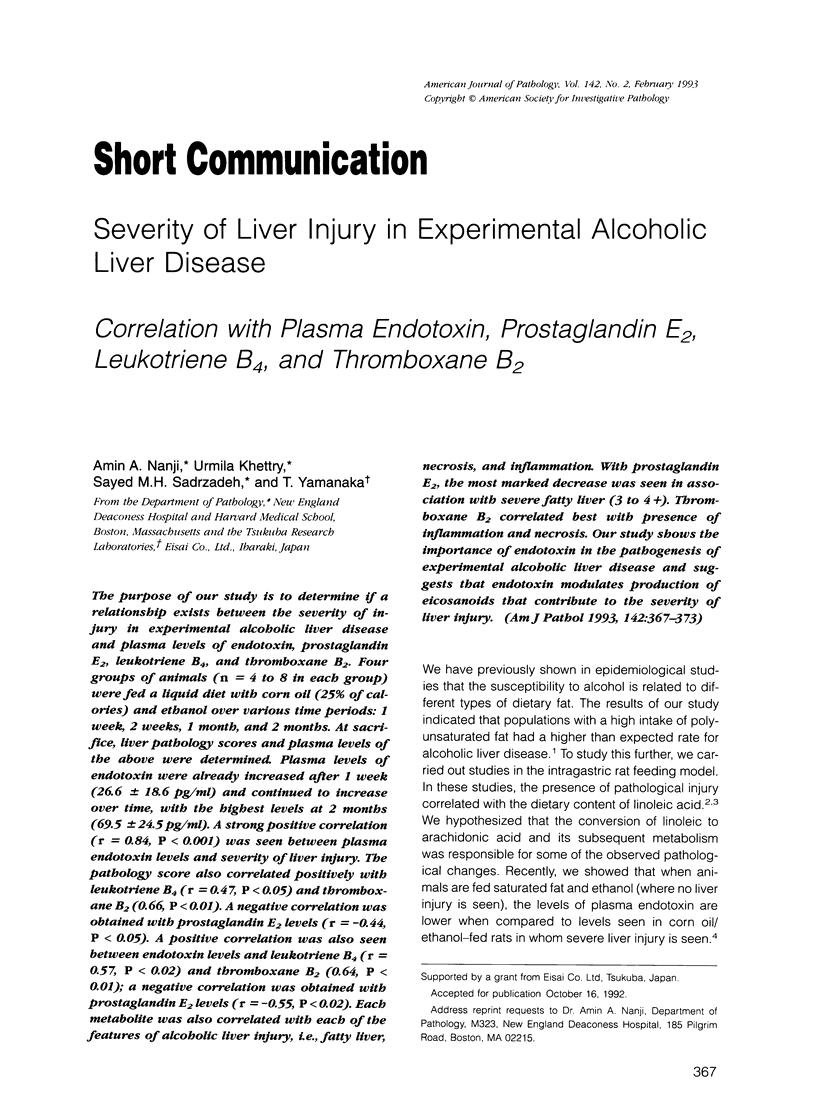
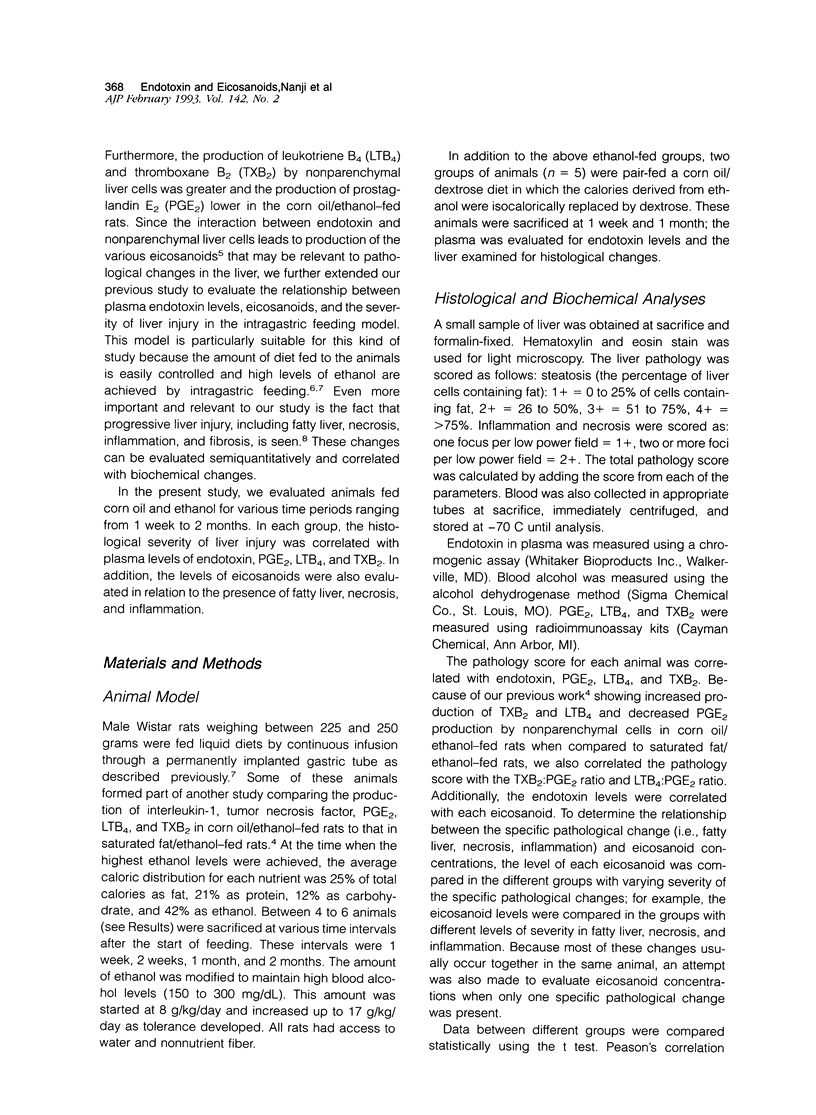
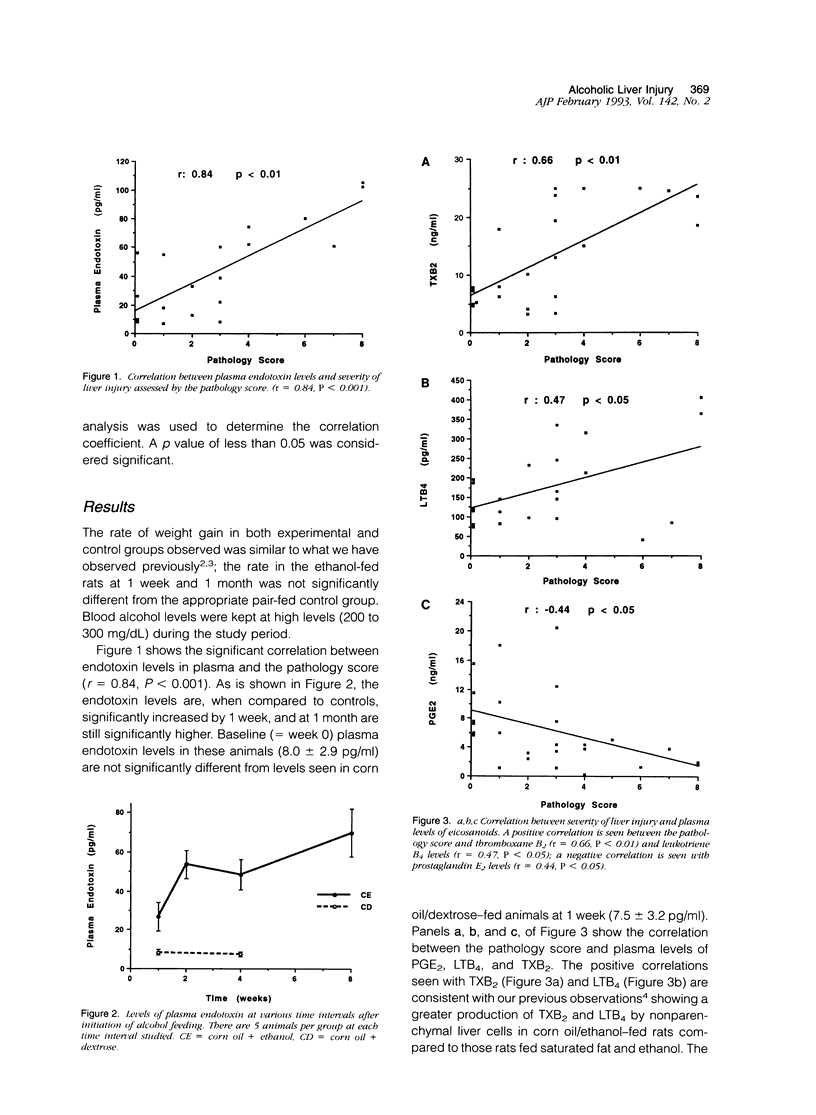
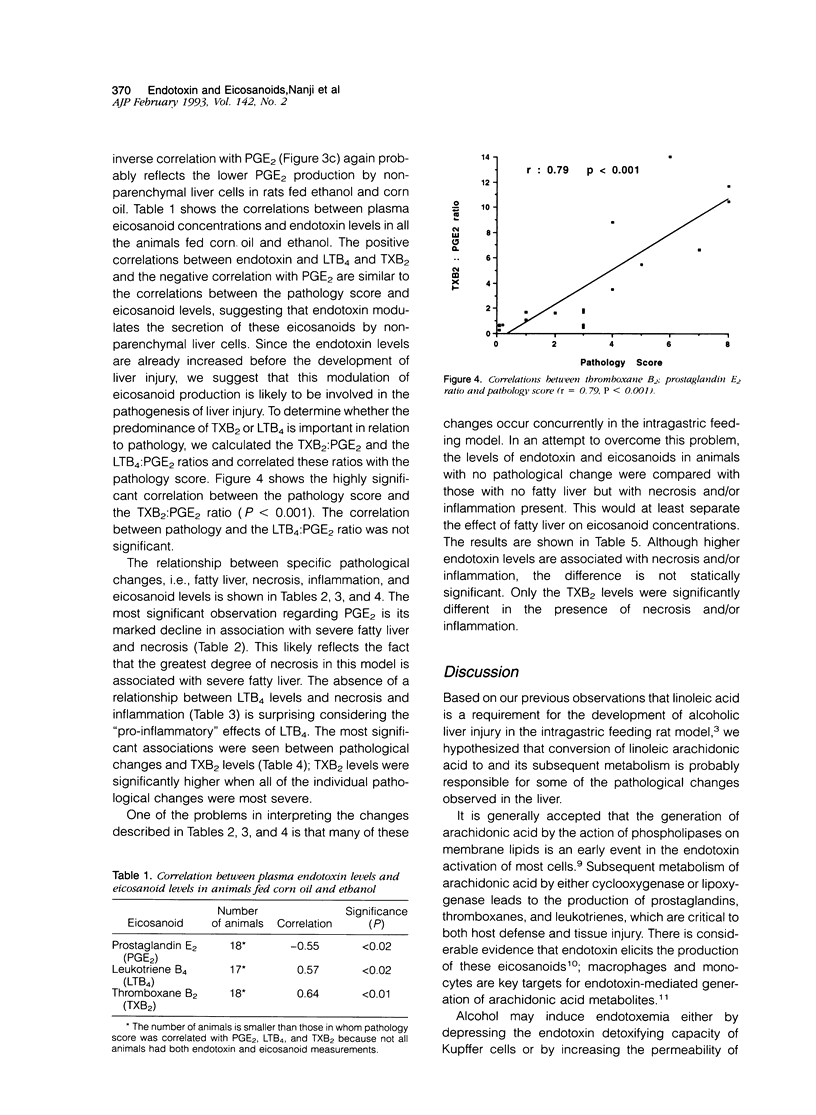
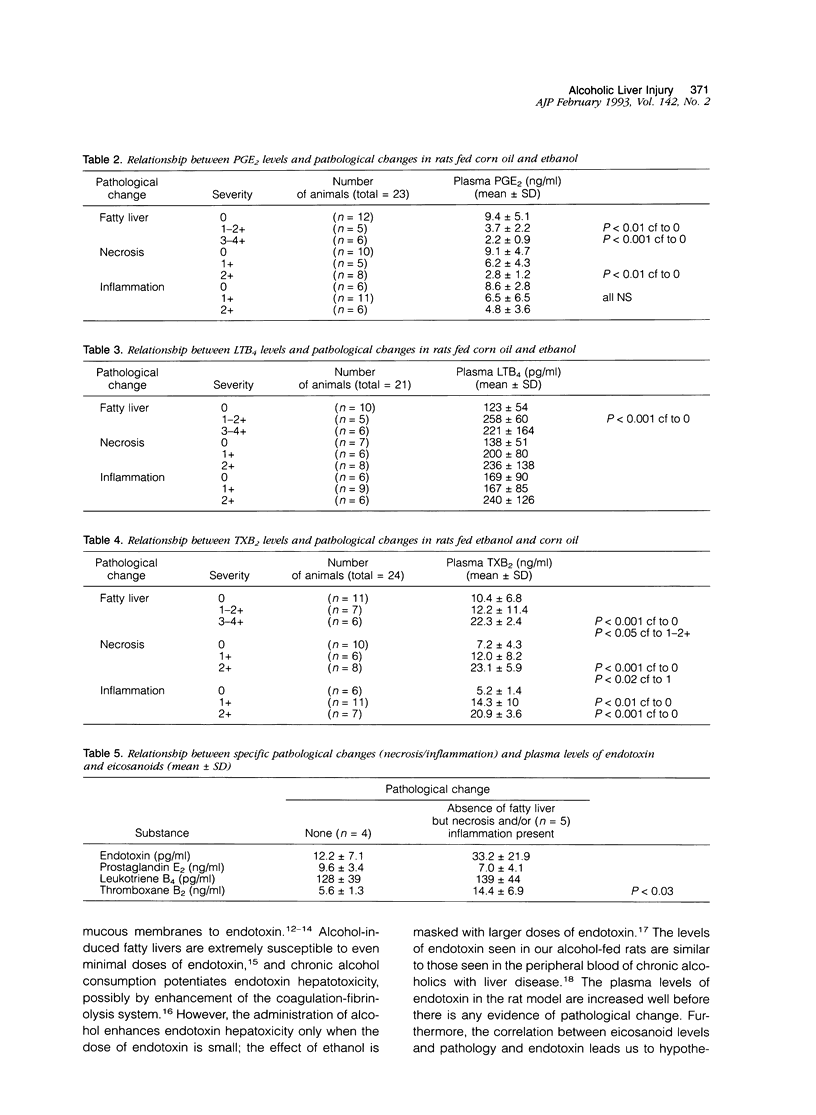
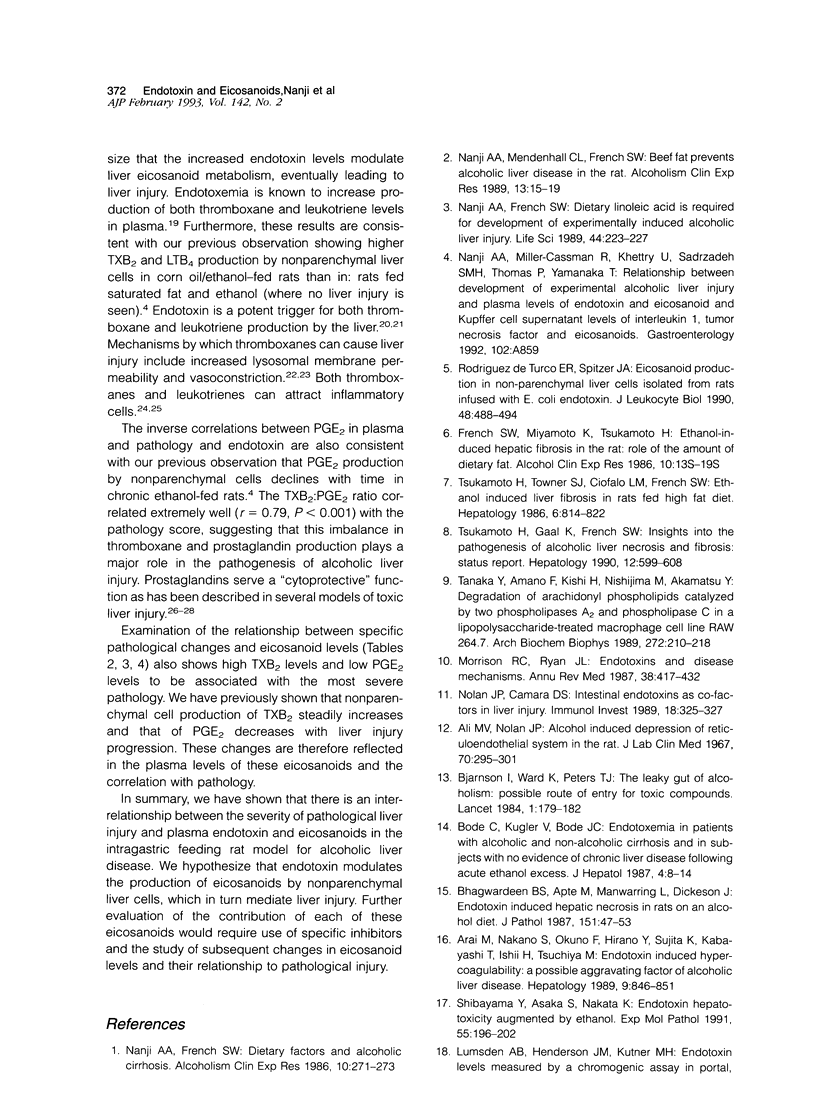
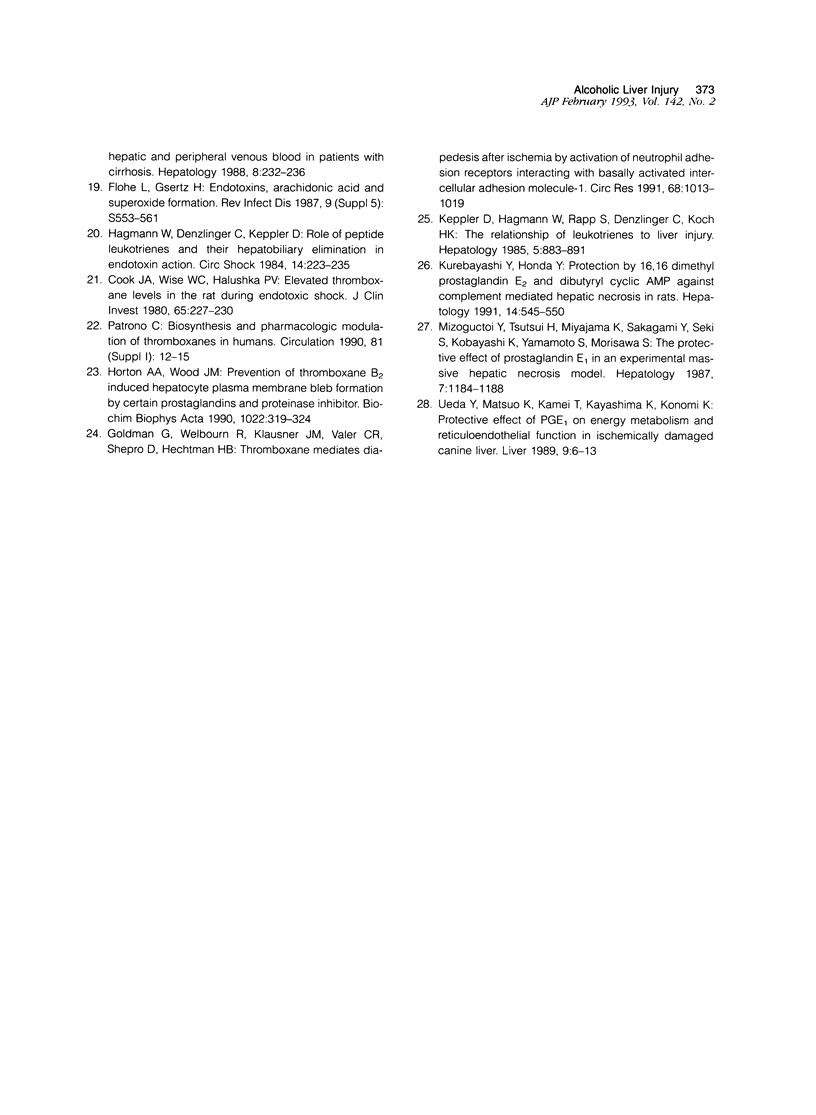
Selected References
These references are in PubMed. This may not be the complete list of references from this article.
- Ali M. V., Nolan J. P. Alcohol induced depression of reticuloendothelial function in the rat. J Lab Clin Med. 1967 Aug;70(2):295–301. [PubMed] [Google Scholar]
- Arai M., Nakano S., Okuno F., Hirano Y., Sujita K., Kobayashi T., Ishii H., Tsuchiya M. Endotoxin-induced hypercoagulability: a possible aggravating factor of alcoholic liver disease. Hepatology. 1989 Jun;9(6):846–851. doi: 10.1002/hep.1840090609. [DOI] [PubMed] [Google Scholar]
- Bhagwandeen B. S., Apte M., Manwarring L., Dickeson J. Endotoxin induced hepatic necrosis in rats on an alcohol diet. J Pathol. 1987 May;152(1):47–53. doi: 10.1002/path.1711520107. [DOI] [PubMed] [Google Scholar]
- Bjarnason I., Peters T. J., Wise R. J. The leaky gut of alcoholism: possible route of entry for toxic compounds. Lancet. 1984 Jan 28;1(8370):179–182. doi: 10.1016/s0140-6736(84)92109-3. [DOI] [PubMed] [Google Scholar]
- Bode C., Kugler V., Bode J. C. Endotoxemia in patients with alcoholic and non-alcoholic cirrhosis and in subjects with no evidence of chronic liver disease following acute alcohol excess. J Hepatol. 1987 Feb;4(1):8–14. doi: 10.1016/s0168-8278(87)80003-x. [DOI] [PubMed] [Google Scholar]
- Cook J. A., Wise W. C., Halushka P. V. Elevated thromboxane levels in the rat during endotoxic shock: protective effects of imidazole, 13-azaprostanoic acid, or essential fatty acid deficiency. J Clin Invest. 1980 Jan;65(1):227–230. doi: 10.1172/JCI109655. [DOI] [PMC free article] [PubMed] [Google Scholar]
- Flohé L., Giertz H. Endotoxins, arachidonic acid, and superoxide formation. Rev Infect Dis. 1987 Sep-Oct;9 (Suppl 5):S553–S561. doi: 10.1093/clinids/9.supplement_5.s553. [DOI] [PubMed] [Google Scholar]
- French S. W., Miyamoto K., Tsukamoto H. Ethanol-induced hepatic fibrosis in the rat: role of the amount of dietary fat. Alcohol Clin Exp Res. 1986;10(6 Suppl):13S–19S. doi: 10.1111/j.1530-0277.1986.tb05175.x. [DOI] [PubMed] [Google Scholar]
- Goldman G., Welbourn R., Klausner J. M., Valeri C. R., Shepro D., Hechtman H. B. Thromboxane mediates diapedesis after ischemia by activation of neutrophil adhesion receptors interacting with basally expressed intercellular adhesion molecule-1. Circ Res. 1991 Apr;68(4):1013–1019. doi: 10.1161/01.res.68.4.1013. [DOI] [PubMed] [Google Scholar]
- Hagmann W., Denzlinger C., Keppler D. Role of peptide leukotrienes and their hepatobiliary elimination in endotoxin action. Circ Shock. 1984;14(4):223–235. [PubMed] [Google Scholar]
- Horton A. A., Wood J. M. Prevention of thromboxane B2-induced hepatocyte plasma membrane bleb formation by certain prostaglandins and a proteinase inhibitor. Biochim Biophys Acta. 1990 Mar;1022(3):319–324. doi: 10.1016/0005-2736(90)90280-2. [DOI] [PubMed] [Google Scholar]
- Keppler D., Hagmann W., Rapp S., Denzlinger C., Koch H. K. The relation of leukotrienes to liver injury. Hepatology. 1985 Sep-Oct;5(5):883–891. doi: 10.1002/hep.1840050530. [DOI] [PubMed] [Google Scholar]
- Kurebayashi Y., Honda Y. Protection by 16,16-dimethyl prostaglandin E2 and dibutyryl cyclic AMP against complement-mediated hepatic necrosis in rats. Hepatology. 1991 Sep;14(3):545–550. [PubMed] [Google Scholar]
- Mizoguchi Y., Tsutsui H., Miyajima K., Sakagami Y., Seki S., Kobayashi K., Yamamoto S., Morisawa S. The protective effects of prostaglandin E1 in an experimental massive hepatic cell necrosis model. Hepatology. 1987 Nov-Dec;7(6):1184–1188. doi: 10.1002/hep.1840070603. [DOI] [PubMed] [Google Scholar]
- Morrison D. C., Ryan J. L. Endotoxins and disease mechanisms. Annu Rev Med. 1987;38:417–432. doi: 10.1146/annurev.me.38.020187.002221. [DOI] [PubMed] [Google Scholar]
- Nanji A. A., French S. W. Dietary factors and alcoholic cirrhosis. Alcohol Clin Exp Res. 1986 Jun;10(3):271–273. doi: 10.1111/j.1530-0277.1986.tb05088.x. [DOI] [PubMed] [Google Scholar]
- Nanji A. A., French S. W. Dietary linoleic acid is required for development of experimentally induced alcoholic liver injury. Life Sci. 1989;44(3):223–227. doi: 10.1016/0024-3205(89)90599-7. [DOI] [PubMed] [Google Scholar]
- Nanji A. A., Mendenhall C. L., French S. W. Beef fat prevents alcoholic liver disease in the rat. Alcohol Clin Exp Res. 1989 Feb;13(1):15–19. doi: 10.1111/j.1530-0277.1989.tb00276.x. [DOI] [PubMed] [Google Scholar]
- Nolan J. P., Camara D. S. Intestinal endotoxins as co-factors in liver injury. Immunol Invest. 1989 Jan-May;18(1-4):325–337. doi: 10.3109/08820138909112246. [DOI] [PubMed] [Google Scholar]
- Rodriguez de Turco E. B., Spitzer J. A. Eicosanoid production in nonparenchymal liver cells isolated from rats infused with E. coli endotoxin. J Leukoc Biol. 1990 Dec;48(6):488–494. doi: 10.1002/jlb.48.6.488. [DOI] [PubMed] [Google Scholar]
- Shibayama Y., Asaka S., Nakata K. Endotoxin hepatotoxicity augmented by ethanol. Exp Mol Pathol. 1991 Oct;55(2):196–202. doi: 10.1016/0014-4800(91)90053-z. [DOI] [PubMed] [Google Scholar]
- Tanaka Y., Amano F., Kishi H., Nishijima M., Akamatsu Y. Degradation of arachidonyl phospholipids catalyzed by two phospholipases A2 and phospholipase C in a lipopolysaccharide-treated macrophage cell line RAW264.7. Arch Biochem Biophys. 1989 Jul;272(1):210–218. doi: 10.1016/0003-9861(89)90212-9. [DOI] [PubMed] [Google Scholar]
- Tsukamoto H., Gaal K., French S. W. Insights into the pathogenesis of alcoholic liver necrosis and fibrosis: status report. Hepatology. 1990 Sep;12(3 Pt 1):599–608. doi: 10.1002/hep.1840120325. [DOI] [PubMed] [Google Scholar]
- Tsukamoto H., Towner S. J., Ciofalo L. M., French S. W. Ethanol-induced liver fibrosis in rats fed high fat diet. Hepatology. 1986 Sep-Oct;6(5):814–822. doi: 10.1002/hep.1840060503. [DOI] [PubMed] [Google Scholar]
- Ueda Y., Matsuo K., Kamei T., Kayashima K., Konomi K. Protective effect of prostaglandin E1 (PGE1) on energy metabolism and reticuloendothelial function in the ischemically damaged canine liver. Liver. 1989 Feb;9(1):6–13. doi: 10.1111/j.1600-0676.1989.tb00371.x. [DOI] [PubMed] [Google Scholar]


